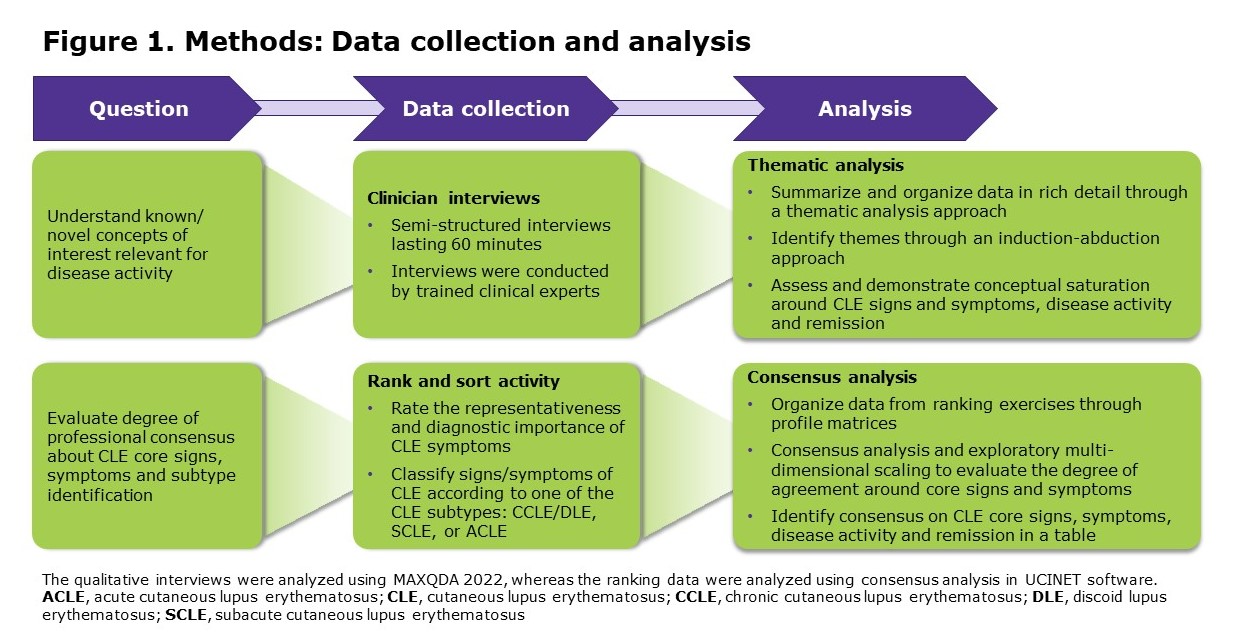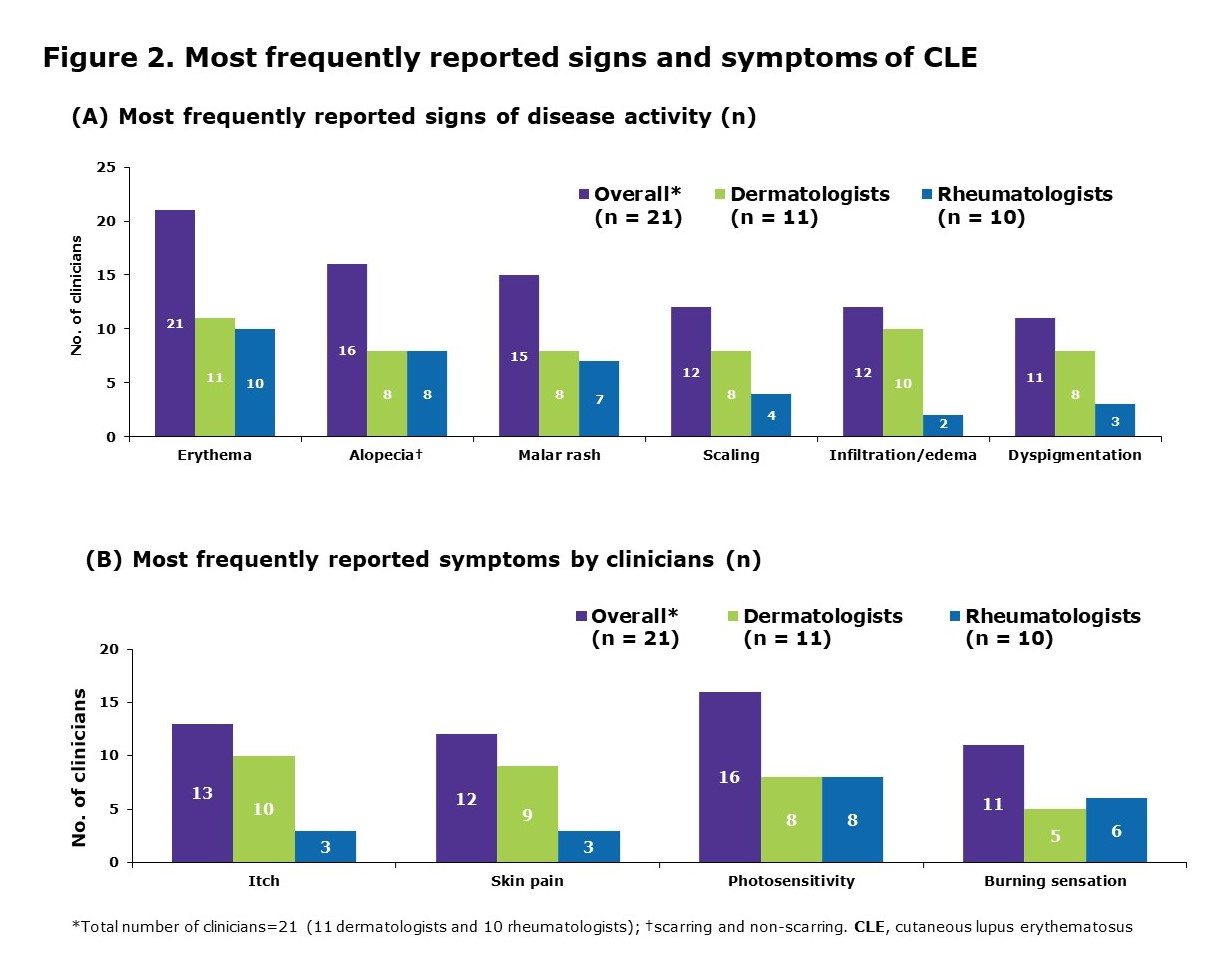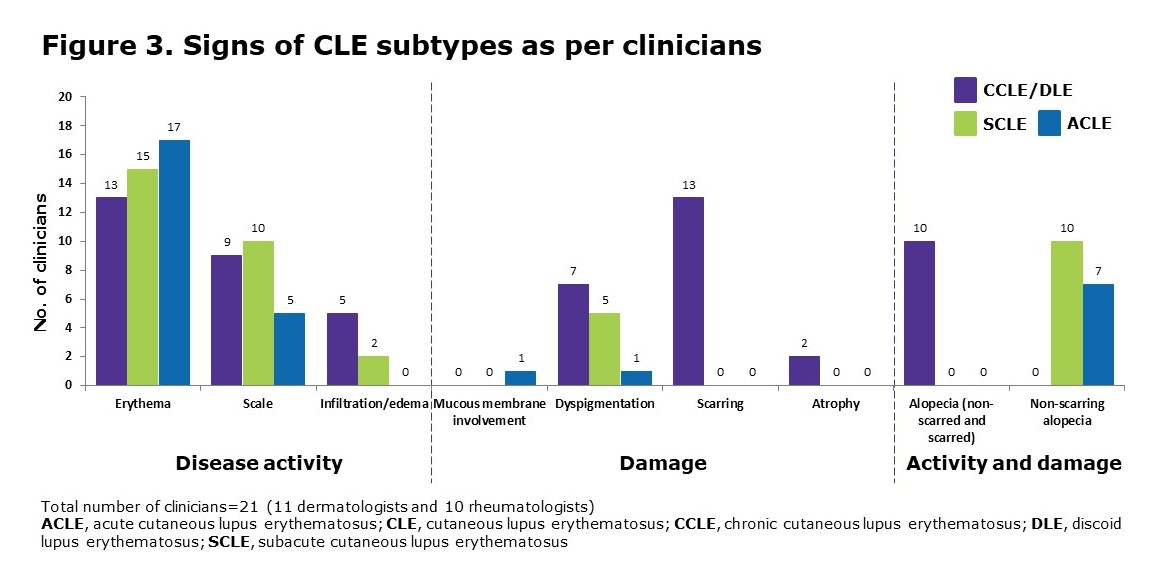Session Information
Date: Sunday, November 12, 2023
Title: (0325–0344) Patient Outcomes, Preferences, & Attitudes Poster I
Session Type: Poster Session A
Session Time: 9:00AM-11:00AM
Background/Purpose: Greater understanding of cutaneous signs and symptoms is needed to comprehensively define and measure cutaneous disease activity in lupus erythematosus. Herein, we interviewed dermatologic and rheumatologic experts: (I) to explore perspectives regarding key signs and symptoms for defining disease activity and damage in cutaneous lupus erythematosus (CLE) subtypes (chronic [primarily discoid], subacute and acute [CCLE [DLE]/SCLE/ACLE]) and (II) to explore potential differences and similarities in clinical signs and symptoms across these CLE subtypes.
Methods: This was a non-interventional, mixed-methods research study, integrating qualitative interviews and latent consensus assessments. Board-certified dermatologists (n=11) and rheumatologists (n=10) based in the United States and Europe with ≥5 years’ experience in treating CLE were interviewed remotely, using a semi-structured interview guide (Figure 1). Data were evaluated by thematic analysis.
Results: Skin lesions in CLE show a broad spectrum of clinical manifestations and, therefore, it is important to use validated skin scores and to evaluate and distinguish disease activity and damage. The most frequently mentioned signs of disease activity by dermatologists included erythema (11/11) and infiltration/edema (10/11) followed by alopecia (scarring and non-scarring), malar rash, scaling and dyspigmentation (8/11 for each) (Figure 2A). The rheumatologists also reported erythema (10/10) as the most frequently mentioned signs of disease activity, followed by alopecia (scarring and non-scarring), malar rash, scaling, dyspigmentation and infiltration/edema (Figure 2A). Itch was the most frequently reported symptom by dermatologists (10/11) whereas photosensitivity was the most frequently reported symptom by rheumatologists (8/10; Figure 2B). Erythema and scaling were associated with all subtypes, but infiltration/edema, mucous membrane involvement, alopecia and non-scarring alopecia varied across subtypes (Figure 3). Most clinicians mentioned that CLE progression is often unpredictable, varied across patients and may be influenced by multiple factors including CLE subtype, sun exposure, smoking and medication compliance. The clinical experts characterized remission as the absence of signs and symptoms, with or without medication. CLE remission is negatively influenced by sun exposure and smoking, whereas medication compliance positively impacts duration of remission.
Conclusion: Signs of CLE associated with disease activity may vary across subtypes and must be considered in the definition and measurement of disease activity. Erythema was the most frequently reported sign related to disease activity and was considered relevant across all CLE subtypes.
To cite this abstract in AMA style:
werth v, Kuhn A, Merola J, Wenzel J, Vazquez-Mateo C, Roy S, Thomas E, Guenther O, Sun Y, Lauer A, Rodriguez A, Koochaki P, Kamudoni P. Core Signs Associated with the Subtypes of Cutaneous Lupus Erythematosus: Concept Elicitation Interviews with Dermatologists and Rheumatologists [abstract]. Arthritis Rheumatol. 2023; 75 (suppl 9). https://acrabstracts.org/abstract/core-signs-associated-with-the-subtypes-of-cutaneous-lupus-erythematosus-concept-elicitation-interviews-with-dermatologists-and-rheumatologists/. Accessed .« Back to ACR Convergence 2023
ACR Meeting Abstracts - https://acrabstracts.org/abstract/core-signs-associated-with-the-subtypes-of-cutaneous-lupus-erythematosus-concept-elicitation-interviews-with-dermatologists-and-rheumatologists/



